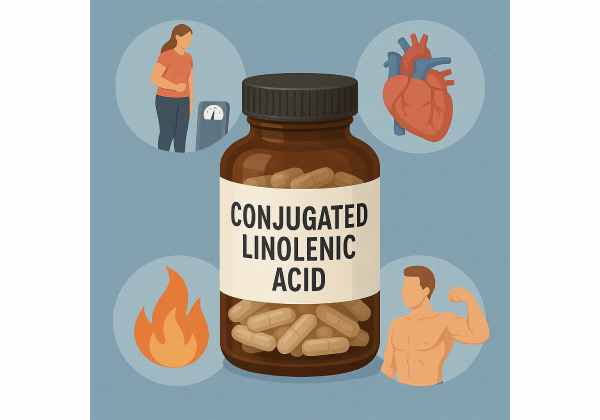Cod Liver Oil for Heart, Brain, and Joint Health: Evidence-Based Benefits and Side Effects
Cod liver oil is a time-honored supplement derived from the livers of Atlantic cod. Rich in omega-3 fatty acids (EPA and DHA), vitamin A, and vitamin D, it’s long been trusted for supporting heart, brain, immune, and joint health. With evidence-based benefits ranging from reducing inflammation to strengthening bones and enhancing vision, cod liver oil is especially valued in...
Codonopsis Root for Energy and Immunity: Benefits and Uses Explained
Codonopsis, often known as “poor man’s ginseng,” is a traditional herbal remedy prized in Chinese and Korean medicine for its gentle yet powerful adaptogenic qualities. The root, commonly called Dang Shen, is celebrated for its ability to bolster vitality, support digestion, strengthen immunity, and reduce fatigue without overstimulation. With a naturally sweet flavor and a reputation for nourishing the...
Coenzyme Q10 Supplement: Top Benefits, How It Works, and Dosage Guidelines
Coenzyme Q10, often known as CoQ10, is a naturally occurring antioxidant found in every cell of your body. It plays a vital role in cellular energy production, supporting heart health, brain function, and overall vitality. Increasingly popular as a supplement, CoQ10 attracts attention for its potential to reduce fatigue, promote cardiovascular health, and even slow age-related decline. As scientific...
Coffee Bean Extract: How It Works, Benefits, Uses, and Proper Dosage
Coffee bean extract has captured global attention for its potential to support weight management, metabolic health, and antioxidant protection. Derived from unroasted green coffee beans, this supplement is rich in chlorogenic acids—a powerful class of compounds with multiple health-promoting properties. Coffee bean extract stands out for its unique combination of gentle energy support (without the jitters of brewed coffee)...
Coffee Charcoal: Complete Guide to Digestive Benefits, Proper Use, and Risks
Coffee charcoal is a traditional natural remedy gaining new interest in the world of modern supplements. Produced by carefully carbonizing green coffee beans, coffee charcoal boasts powerful adsorptive properties—meaning it can bind and neutralize toxins and irritants in the digestive tract. Used for centuries across Europe, especially in German and herbal medicine, it is valued for soothing digestive complaints,...
Coix Seed Extract: Top Health Benefits, Dosage, and Side Effects Explained
Coix seed extract, also known as Job’s tears or Coix lacryma-jobi, has been treasured for centuries in traditional Asian medicine and is now gaining popularity worldwide as a versatile wellness supplement. Derived from the seeds of the coix plant, this natural extract is celebrated for its gentle diuretic, anti-inflammatory, and immune-supportive effects. With a unique profile of polysaccharides, lipids,...
Colchicine: Gout Relief, Dosage, Benefits, Side Effects & Safety
Colchicine is a centuries-old medicinal compound originally derived from the autumn crocus (Colchicum autumnale). Today, it’s widely recognized as an effective prescription medication for managing gout, familial Mediterranean fever (FMF), and several inflammatory conditions. Colchicine stands out for its unique ability to interrupt inflammatory pathways and rapidly reduce joint pain and swelling. As research uncovers broader potential—including heart health...
Coleus forskohlii Extract: Forskolin’s Effects, Fat Loss, Dosage, and Safety
Coleus forskohlii, a vibrant plant native to India and Southeast Asia, has emerged as a powerhouse in the world of herbal supplements. Valued for centuries in traditional Ayurvedic medicine, this member of the mint family is best known for its unique active compound—forskolin. Recent research has spotlighted Coleus forskohlii extract for its potential to support weight management, promote healthy...
Collagen peptides: Skin, Joint, Hair Benefits, Dosage, and Side Effects Explained
Collagen peptides have become one of the most popular and trusted supplements for skin, joint, and whole-body health. These easily absorbed protein fragments, derived from animal or marine sources, supply the body with the building blocks it needs to maintain healthy skin elasticity, joint function, hair, nails, and even gut lining. As collagen production naturally decreases with age, supplementation...
Collagen type I: Top Health Benefits, Science, Uses, Dosage, and Side Effects
Collagen type I is the most abundant form of collagen found in the human body, vital for maintaining healthy skin, bones, tendons, and connective tissues. As we age, our body’s natural collagen production declines, leading to wrinkles, joint discomfort, and weaker bones. Supplementing with collagen type I has gained significant attention for its ability to support youthful skin, promote...
Collagen type II: Essential Joint Supplement Benefits, Properties, and Side Effects
Collagen type II is a specialized form of collagen that plays a vital role in joint health, cartilage structure, and connective tissue support. While collagen type I is known for its skin and bone benefits, type II collagen is most abundant in cartilage, providing the cushioning and flexibility joints need for smooth, pain-free movement. As we age or experience...
Colloidal gold: What It Does, How to Use It, Benefits, Dosage, and Warnings
Colloidal gold is a suspension of ultra-fine gold nanoparticles in liquid, renowned for its use in wellness circles and alternative medicine for centuries. Modern interest in colloidal gold focuses on its potential to support cognitive function, mood balance, inflammation reduction, and overall cellular health. The unique physical properties of gold nanoparticles allow them to interact with biological systems in...
Colloidal silver: Top Benefits, Antimicrobial Uses, Dosage, and Side Effects
Colloidal silver is a suspension of microscopic silver particles in liquid, long promoted in alternative health circles for its purported antibacterial, antiviral, and immune-boosting properties. Once used extensively before the advent of antibiotics, colloidal silver has experienced a modern resurgence as a supplement, topical remedy, and household solution. Advocates claim it can support immune function, speed wound healing, and...
Colocynth: Herbal Remedy Benefits, Uses, Dosage, and Toxicity Explained
Colocynth, also known as Citrullus colocynthis or bitter apple, is a powerful herbal remedy with roots in traditional medicine across North Africa, the Middle East, and South Asia. Historically celebrated for its potent laxative properties and ability to manage digestive complaints, colocynth is now being revisited for its wide array of phytochemicals, potential anti-inflammatory, antidiabetic, and antimicrobial benefits. Despite...
Colombo Root: Digestive Health, Properties, Safe Dosage, and Risks Explained
Colombo, often known as calumba or Jateorhiza palmata, is a medicinal root native to East Africa, prized in both traditional and modern herbal medicine. Known for its distinctive bitterness and gentle, non-irritant digestive effects, colombo has long served as a natural tonic for the stomach, helping to improve appetite, support healthy digestion, and soothe mild gastrointestinal discomforts. Today, this...
Coltsfoot Supplement: Respiratory Benefits, Proper Dosage, Safety, and Risks
Coltsfoot (Tussilago farfara) is a time-honored botanical celebrated for its soothing effects on the respiratory system. Used for centuries in traditional European and Asian medicine, coltsfoot’s bright yellow flowers and broad, hoof-shaped leaves have been valued as natural remedies for coughs, bronchitis, and throat irritation. Modern interest in coltsfoot centers around its unique blend of mucilage, antioxidants, and anti-inflammatory...
Columbine in Herbal Medicine: Benefits, Usage, Precautions, and Safety Profile
Columbine (Aquilegia spp.), with its distinctive spurred flowers, has long held a place in herbal tradition for its purported therapeutic uses. While admired for its beauty in gardens, columbine’s roots, seeds, and foliage have been referenced in folk remedies for centuries, especially in Europe and North America. However, the plant contains bioactive alkaloids that require careful, knowledgeable use. This...
Combretum micranthum Benefits: Liver Health, Detox, Dosage, and Side Effects Explained
Combretum micranthum, commonly known as Kinkeliba, is a traditional herbal remedy treasured across West Africa for its array of wellness benefits. This medicinal plant has gained global attention for its role in supporting liver function, aiding digestion, and helping manage blood sugar levels. As more people seek natural ways to optimize health, Kinkeliba stands out for its antioxidant, anti-inflammatory,...
Comfrey: Complete Guide to Topical Benefits, Healing Uses, Dosage, and Side Effects
Comfrey (Symphytum officinale) is a centuries-old herbal remedy cherished for its remarkable healing properties. Traditionally, it has been used to support wound healing, soothe muscle aches, and promote joint comfort. Its active compounds, notably allantoin and rosmarinic acid, help stimulate tissue regeneration and reduce inflammation. Today, comfrey is still valued in natural wellness circles, though its internal use is...
Common stonecrop Herbal Remedy: Wound Healing, Skin Care, Uses, and Side Effect Risks
Common stonecrop (Sedum acre), a resilient succulent native to Europe, Asia, and North Africa, has long been prized in traditional herbal medicine. Known for its thick, fleshy leaves and clusters of star-shaped yellow flowers, this low-growing plant thrives in poor soils and rocky landscapes. Beyond its ornamental value, common stonecrop offers a wealth of health-supporting properties: it’s traditionally used...
Condurango: Digestive Support, Bitter Tonic Benefits, Dosage, and Side Effects
Condurango (Marsdenia cundurango), a woody vine native to the Andean regions of South America, has been treasured in traditional herbal medicine for over a century. Renowned for its bitter, bark-derived remedy, condurango is most commonly sought after for its potential to soothe digestive troubles, stimulate appetite, and support upper gastrointestinal health. Its unique phytochemistry has also attracted interest as...
Conjugated linoleic acid: Weight Loss, Fat Reduction, Benefits, Dosage, and Side Effects
Conjugated linoleic acid (CLA) has emerged as one of the most discussed and studied dietary supplements in the wellness world. Found naturally in meat and dairy from grass-fed animals, this unique fatty acid boasts a distinct molecular structure believed to confer a range of health benefits. Many people turn to CLA for its potential in fat loss, body composition...
Conjugated linolenic acid Supplement: Fat Metabolism, Health Benefits, Dosage, and Risks
Conjugated linolenic acid (CLnA) has gained increasing attention for its promising role in supporting metabolic wellness, inflammation balance, and cellular health. Unlike its cousin conjugated linoleic acid (CLA), CLnA is a group of omega-3 and omega-6 fatty acids found in specific plant oils such as pomegranate seed oil, bitter melon seed oil, and tung oil. Recent research suggests these...
Contrayerva Supplement: Immune Support, Detoxification, Benefits, Dosage, and Risks
Contrayerva, also known as Dorstenia contrajerva, is a time-honored medicinal root native to Central and South America. Celebrated for centuries in traditional herbal medicine, Contrayerva is valued for its broad spectrum of uses, including digestive support, fever reduction, immune boosting, and detoxification. As modern research explores its phytochemical makeup, Contrayerva continues to attract interest for its anti-inflammatory, adaptogenic, and...




























